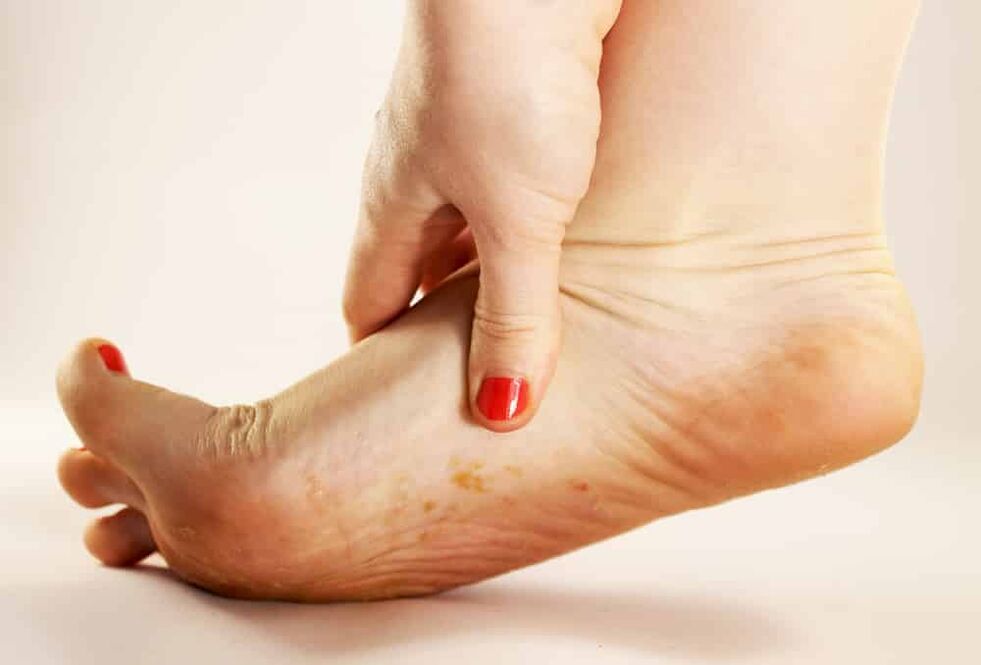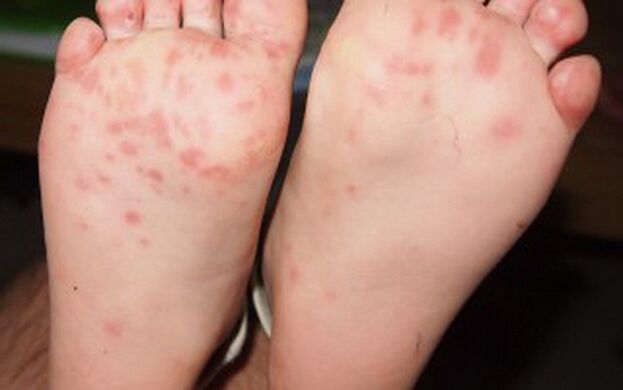"How to cure foot fungus", "how to quickly get rid of onychomycosis, foot fungus, gain eternal youth and defeat death". They are all questions of the same level. The fungus on the legs cannot be treated quickly and reliably, especially with home methods. You still need a dermatologist.
Foot mycosis is a skin disease caused by the spread of parasitic fungi and is one of the most common ailments affecting human skin (photo).
The disease is quite difficult to treat and leads to complications, as it rarely starts on time.

Often, a person infected with a fungal infection does not pay attention to the symptoms, and the bacteria have time to "settle" firmly on the skin.
Causes of foot fungus
The high prevalence of foot mycosis is explained by the fact that the disease is easily transmitted from person to person at the contact-family level.
Pathogens love a humid, warm environment that encourages fungal growth.
Pools, gyms, baths and saunas - where a person can step on the floor with bare feet, are some of the first places where a fungus can be picked up.
The use of household items and personal items of a person with foot fungus (towels, washcloths) inevitably leads to infections.
The second reason for the spread of fungal infection and the formation of mycosis of the foot is non-compliance with the rules of personal hygiene, increased sweating of the legs.
Also rarely changing socks and putting them on wet feet creates all favorable conditions for the growth of fungus on the feet.
Symptoms of a fungus on the feet
There are several forms of foot mycosis, the symptoms of which have distinctive features.
Erased form of toe mushroom
Symptoms of this form of foot mycosis are insignificant and this is the insidiousness of the skin disease.
Slight dryness and peeling of the dermis is accepted by a person as an absolutely normal physiological phenomenon.
While the gaps that appear between the fingers are considered diaper rash, they are actually symptoms of fungal exposure.
Squamous-hyperkeratic form of the foot fungus
The most common form of foot mycosis among the population over the age of 60 is moccasin foot.
So it is called due to the obvious visible signs that appear on the surface of the foot:
- rough thickened skin over the entire surface;
- cracks, corns (hyperkeratosis);
- nail lesion attachment;
- the color is dirty gray, with yellow;
- unpleasant smell;
- separation of the stratum corneum, scales;
- pain when walking and inability to wear shoes.
Vesicular form of the foot fungus
Fungal infections of the foot, with symptoms in the form of blistering formations with a thick horny layer, are called the wet form of a fungal infection.

The blisters that appear over time open and become like eczema, ulcers, psoriasis.
In general, foot mycoses manifest themselves in different ways.
The disease can start with cracked heels, blistering and itching, severe diaper rash, or rough skin.
Skin peeling cannot be left unnoticed when exfoliating in large or small flakes from the foot.
There is also an unpleasant smell, the legs sweat quickly and, after being in the shoes, the foot "burns" and itches.
Complications that arise from a careless attitude to the symptoms of the disease manifest themselves in the form of erosions and painful wounds on the legs, which sometimes cannot be completely healed.
Foot fungus treatment
For the treatment of foot mycosis, new generation antimyotics are used. They are not that harmful to the liver and are very effective.
However, the fungus is insidious as it rapidly develops resistance to various types of drugs, thereby causing relapses.
To cure a foot fungal infection, an accurate diagnosis needs to be established by identifying what type of mycosis has spread to the skin. To do this, scraping for the fungus is performed.
Comprehensive treatment, with an accurate regimen of taking drugs, both local and systemic, should be determined only by a specialist, since self-medication leads to an aggravation of the problem.
And the third point of successful treatment is the patient's strict discipline in taking medications, adhering to a diet, and taking preventative measures.
Different treatment regimens are used for mycosis of the foot - combined and monotherapy.
And if a drug is selected for monotherapy, more often for external use.
This combined scheme involves several directions in treatment at the same time:
- outdoor remedies;
- tablets for internal use;
- laser exposure;
- hardware pedicure.
External remedies for foot fungus
The most effective, capable of affecting the fungus, is a substance that destroys both mold and yeast-like fungi, can fight dermatophytes and infections of non-fungal origin, which are often associated with mycosis of the foot.
This substance can be presented in various forms: spray, cream or gel, solution, etc.
The products act on the principle of forming a protective film, which can be held on the surface of the skin for up to 72 hours.
External drugs are applied in the amount prescribed by the doctor, but often the procedure is carried out 1-2 times a day for 2-4 weeks, then the treatment continues, but according to a different scheme.
Before applying the ointment or cream, the foot is cleaned.
Salicylic acid compresses are made to remove the stratum corneum, soap and soda baths, Vaseline-based ointment is used to soften and remove dead tissue.
Such procedures are performed in special rooms for medical pedicure, using accessories for grinding.
Before treating mycosis of the feet with a wet type, it is necessary to wipe ulcers and blisters with boric acid, bright green or iodine.
To prevent the spread of the fungus on the nails, special varnishes are prescribed against onychomycosis.
But the vesicular form of mycosis will require the addition of corticosteroids to the treatment regimen.
How to cure a fungus on the feet - systemic therapy
Taking antifungals inside is not indicated for all patients with foot mycosis.
The drugs are quite toxic, so pregnant and lactating women, young children, the elderly and those with liver dysfunction are not prescribed.
According to the instructions attached to the drug or according to the scheme prescribed by the doctor, tablet forms of antifungals are taken.
Recently, drugs that relieve foot and nail fungus in 1 course have proven themselves effective, relieve itching, peeling and irritation of the skin of the legs after the first application.
Folk remedies for the treatment of fungus on the feet
If there are categorical contraindications for the treatment of mycosis of the foot with drugs, then you can try folk remedies.
How to cure foot fungus at home:
- The acid present in wine vinegar or table vinegar (9%) is an effective folk remedy against fungi. It is used to lubricate the surface of the skin affected by mycosis and to wear over cotton socks. Leave it overnight. It is not recommended to use vinegar for those with leg wounds or sores. In this case, it is better to reduce the concentration of the folk remedy or replace it with a more gentle one.
- Brewed coffee shows good results. It is necessary to prepare the drink stronger and enough that you can completely immerse your feet in it. For prevention, alternative treatment is performed on two limbs at the same time, even if mycosis is observed only on one. Perform the procedure before bedtime.
- Celandine foot baths also act as an effective folk remedy that can rid your feet of fungus in a month. Prepare a bath at the rate of 4 tablespoons. l for 1 l. water. The grass is boiled, after which the legs soar in a hot collection for up to half an hour. You can also take a stronger harvest of herbs for brewing: oak bark, chamomile, knotweed, sage, eucalyptus, and fir needles. They all have excellent antifungal properties.
- You can also use lotions of a local anesthetic drug by moistening a cotton sponge in a medicinal solution and applying it to the affected area. A folk remedy quickly relieves the symptoms - pain and itching.
Foot fungus prevention
Effective treatment of mycosis of the foot is possible subject to the following preventive measures:
- Mandatory disinfection of the insoles and inner surface of shoes, the thicker the better. To do this, use special antifungal shoe sprays or alcohol;
- it is advisable to change the bed linen daily and it is necessary to wash it at high temperatures;
- disinfect the surface of the bathroom or shower cubicle, and also refuse to visit public toilets during treatment;
- in public places, do not allow yourself to walk barefoot and dry your feet before putting on shoes;
- it is necessary to treat the fungus immediately with all family members, otherwise someone will be constantly infected;
- follow a diet - do not eat allergenic foods, smoked meats, preserves, very salty and peppery foods, sweets.
























